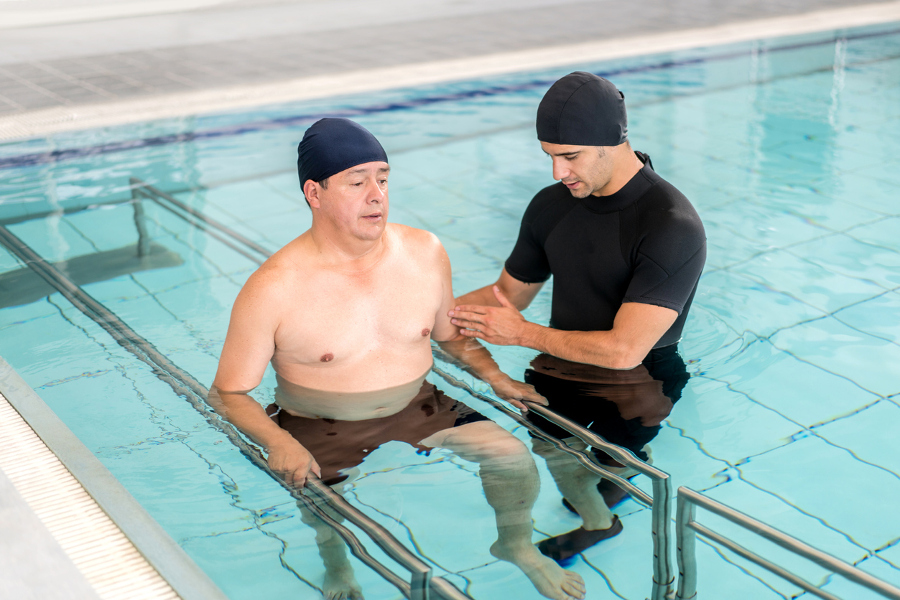Age and back injuries can make exercising difficult. The fear of reinjuring yourself or exacerbating your existing injury may make you shy away from any form of aerobic and/or strengthening exercises. Rather than avoiding exercise, find a safe way to work out your core muscles without injury. Aquatic therapy, or water exercises, help build core muscles and relieve back pain at the same time.
The Cleveland Clinic shares how the warm water from a pool, therapeutic pool, water jets, or spa provide direct relief to the injured areas. Heat helps relax tight muscles and reduces tension that may be responsible for part of the existing back pain. The warmth also encourages blood flow, aiding in the healing process. Buoyancy reduces the strain on injured muscles or joints and prevents additional injury, yet the water itself offers resistance providing an excellent natural muscle-building workout. For those who dislike sweating, the water wicks away sweat and helps cool the body, preventing overheating.
Along with helping decrease pain, Very Well Health shares the additional benefits of increased range-of-motion for joints and better balance and stability. For those who are unsteady on their feet, aquatic therapy removes the fear of falling and injury. A benefit that most people don’t stop to consider is the added factor of fun. Many equate a pool and swimming with good times and good memories. What is meant as a workout simply becomes pleasurable.
On average, an aquatic therapy session lasts thirty to forty minutes and can be done two to three times a week. Every session should include a warm-up, workout, and cool-down. The American Physical Therapy Association (APTA) lists several exercises you can expect to see during a workout session.
- Warm-up: A warm-up routine, whether you’re doing aquatic therapy or land exercise, helps get the blood flowing to the muscles before hard exercise begins. It helps prevent injuries that can otherwise occur. Aquatic warm-ups generally include walking. The APTA recommends walking both forward and backwards, ten steps in each direction, in waist-high or chest-high water. Gently increase your speed from a walk to a jog and then alternate between jogging and walking at thirty second intervals for five minutes. Remember to continue to alternate between forwards and backwards, giving your legs and lower back a total warm-up.
- Pool planks: For upper body, shoulder, and core workouts, pool planks may be used. With a noodle held horizontally between your hands, shoulder-width apart, lean into a plank position submerging the noodle. Keep your elbows straight and your feet firmly planted on the pool floor. Hold the position for fifteen to sixty seconds and release. Do three to five repetitions.
- Twists: Strengthening and toning the abdominal muscles add to stability and core strength. The APTA’s recommended abdominal workout says to move to deep water. Use a floatation device under your arms or around your waist for safety. Draw both knees to the chest and then rotate them right and left. Lower them and repeat the process ten times.
- Deep water bicycle: For a cardiovascular, core, and leg workout, try doing the bicycle. Loop one to two noodles around your back and under your arms. Lean back and move your legs like you’re riding a bicycle for three to five minutes.
- Knee lift: The knee lift aids in developing balance and core strength. Move to the side of the pool and stand with one side against the pool wall. Lift one knee to form a ninety-degree angle like you are marching and lower it. Repeat ten times; then do the other side. If this seems too easy, move away from the pool wall and do the exercise in the middle of the pool where you don’t have the wall to aid with stability.
- Cool down: Be sure to end your session with a cool down. You might want to go back to the walking to allow your body to relax.
APTA gives a word of caution to those who practice aquatic therapy. Because you are in the water, you may not realize you are sweating. Be sure to adequately hydrate yourself. Also, never “push through” pain. If it hurts, stop the activity and try something else.
As you age, you need to continue to exercise so that you remain strong. Finding ways to get appropriate exercise without injury is the challenge. Try aquatic therapy and see how it can help strengthen your body without causing additional pain.


